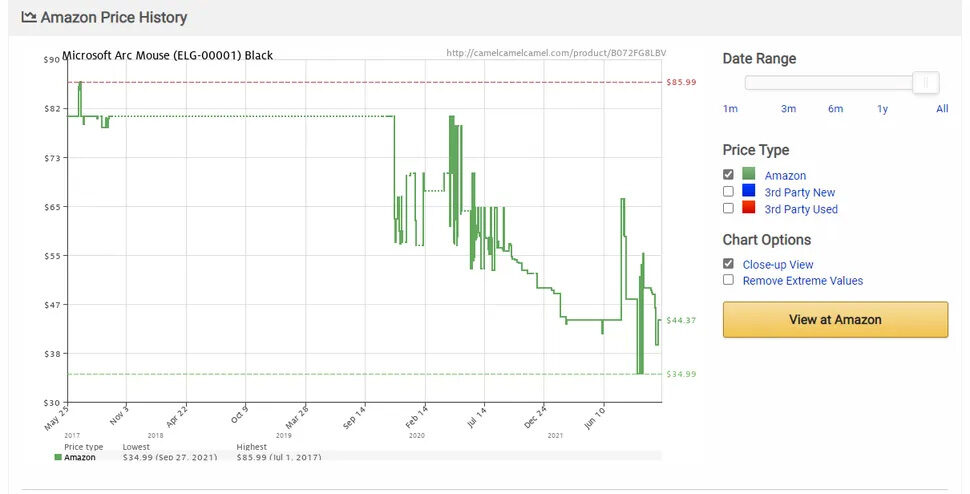What’s the need for a price change tracker? Pricing is one of the main factors that determines whether the customer buys the product or moves to another variant. A variant in this case could mean another platform offering a better price, another seller who has displayed the product at a lower price, or even a completely different brand offering a similar item.
This is where dynamic pricing strategies – where the prices fluctuate frequently – come into play and staying ahead of price changes via a price change tracker becomes crucial. To ensure that your brand or product performs well in the marketplace and generates steady revenue, businesses must have a comprehensive understanding of market dynamics and adjust their pricing strategies accordingly.

Image Source: Prisync
Let’s take a look at how an essential tool such as a price change tracker can make a difference to your business.
How Does a Price Change Tracker Work?
In a nutshell, a price change tracker is a tool that tracks and monitors price fluctuations in real time. By collecting data from multiple sources such as competitor websites, e-commerce marketplaces, and brand-native websites, the tool provides intelligence on product pricing trends and information that’s up-to-date.
A price change tracker or an e-commerce analytics platform provides users with –
Identify pricing patterns
A well-designed pricing tracker provides timely data on pricing fluctuations, allowing brands to keep track of the current market environment. Working on this data, businesses can see trends and patterns where the product cost rises or lowers and make the necessary adjustments in their own strategies.
For example, a makeup brand using a price change tracker sees its main competitor lower product costs on the weekend. This may be on products customers are more like to make an impulse purchase on – such as lipsticks or blushes. With this knowledge, the makeup brand can also compete during the same time so consumers can consider their brand as well.
Data to optimize profitability
Though dynamic pricing can seem like a good product pricing strategy, it has its shortcomings when used incorrectly. When lowered too much or at the wrong time, the business can stand to make marginal profits or lose out on money by not pricing it correctly.
A price change tracker can analyze current trends and historical data to identify the most profitable price points for their products. This can strike the perfect balance between attracting customers and maximizing profit margins.
Competitive analysis
In line with the above point, as businesses analyze historical data, various pricing patterns emerge and businesses can perform a thorough competitor analysis.
This data would allow brands to gain insights into their competitor positioning, see any gaps where their own strategies fall short, and make the necessary adjustments to drive revenue.
Competitor analysis can also be used to gauge how market leaders perform online and use that data as a benchmark or knowledge-learning tool. It can showcase new strategies that can be adapted to your own business or modified so it works for your product.

What to Look at While Implementing a Price Change Tracker
To successfully implement a price change tracker, businesses must consider adopting these key steps –
1. Identifying key competitors and products
Before making any changes, businesses need clarity on what to track and whom to monitor. This involves:
- Identifying primary competitors (direct competitors) and secondary competitors (indirect competitors or substitutes).
- Determining the specific products or categories to monitor.
- Understanding which price points (e.g., promotional discounts, regular pricing, or subscription rates) are most relevant to your market.
This step is foundational, as it helps define the scope of the tracker and ensures resources are focused on gathering meaningful data.
2. Selecting the right price change tracker
Not all price change trackers are created equal, so selecting one tailored to your business needs is crucial. Features to prioritize include:
- Comprehensive data collection: A tracker should provide insights into MAP (Minimum Advertised Price) violations, competitor pricing trends, and product availability.
- User-friendly dashboards: Tools like 42Signal’s e-commerce analytics platform integrate multiple insights in a single place, making it easier to monitor and act on pricing information.
- Scalability and customization: As your business grows, the tracker should adapt to new products, markets, or competitors.
The right tool saves time, ensures accuracy, and delivers actionable insights.

Image Source: 42Signals
3. Analyzing data to guide decisions
Tracking prices alone is not enough; the real value lies in analyzing the data to:
- Identify trends: Understand historical pricing patterns and anticipate market movements.
- Respond to competitor actions: Make timely adjustments to your pricing or promotional strategies.
- Optimize profitability: Use data to strike the right balance between competitive pricing and maintaining healthy profit margins.
Leveraging analytics tools that can segment data by product categories, regions, or customer segments provides a more nuanced understanding of the market.
4. Integrating the Tracker with Business Workflows
To maximize the benefits of a price change tracker, it must be seamlessly integrated into existing business processes:
- Team alignment: Ensure marketing, sales, and procurement teams have access to the insights they need.
- Automation: Use alerts and automated reporting features to stay updated without manual monitoring.
- Real-time updates: For markets where prices change frequently, such as e-commerce or retail, real-time data integration is critical.
5. Evaluating the Price Change Tracker’s Performance
Regularly assess whether the price change tracker is meeting your goals:
- Is it providing the data needed to make informed pricing decisions?
- How accurate and timely is the information?
- Are there additional features or integrations that could enhance its utility?
By continually refining the system, businesses can ensure that their price tracking remains aligned with market dynamics and organizational objectives.
Conclusion on Price Change Tracker
A price change tracker provides businesses with the necessary tools to monitor competitor pricing, optimize profitability, and implement dynamic pricing strategies. With this data, businesses can outperform their competitors and witness the change firsthand by adopting the right practices.
42Signals provides this data and more by leveraging AI to anticipate consumer demand, track competition, optimize digital shelves, and grow online sales. To know more about the platform or for a demo, contact sales@42signals.com




